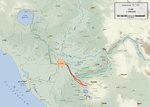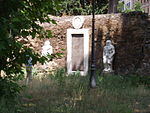Santa Bibiana
17th-century Roman Catholic church buildings in ItalyChurches of Rome (rione Esquilino)Gian Lorenzo Bernini church buildingsRoman Catholic churches in Rome

Santa Bibiana is a small Baroque style, Roman Catholic church in Rome devoted to Saint Bibiana. The church façade was designed and built by Gian Lorenzo Bernini, who also produced a sculpture of the saint holding the palm leaf of martyrs.
Excerpt from the Wikipedia article Santa Bibiana (License: CC BY-SA 3.0, Authors, Images).Santa Bibiana
Via Giovanni Giolitti, Rome Municipio Roma I
Geographical coordinates (GPS) Address External links Nearby Places Show on map
Geographical coordinates (GPS)
| Latitude | Longitude |
|---|---|
| N 41.895552777778 ° | E 12.509188888889 ° |
Address
Chiesa di Santa Bibiana
Via Giovanni Giolitti
00185 Rome, Municipio Roma I
Lazio, Italy
Open on Google Maps









